| advanced |
TUTORIALS
- ARTS/125
- BCOM/231
- BCOM/231
- BIS/221
- BSA/310
- BSA/375 (NEW)
- BSA/376
- BSA/385 (NEW)
- BSA/515 (NEW)
- BSA/520 (NEW)
- BSA/525 (NEW)
- BSA/550 (NEW)
- BSCOM/100
- BUS/210
- BUS/212 (NEW)
- BUS/475 T (NEW)
- CIS/207 T (NEW)
- CIS/291
- CMGT/245 (NEW)
- CMGT/400 (NEW)
- CMGT/410 (NEW)
- CMGT/430
- CMGT/431 (NEW)
- CMGT/433 (NEW)
- CMGT/442 (NEW)
- CMGT/445 (NEW)
- CMGT/545 (NEW)
- CMGT/582 (NEW)
- CMGT/583 (NEW)
- COM/295
- COM/295 T (NEW)
- CSS/422 (NEW)
- CYB/110 (NEW)
- DBM/380
- ECO/365
- ECO/365 T (NEW)
- ECO/372
- ECO/372 T (NEW)
- ENG/220
- ENG/222
- ENG/223
- ENV/100
- ENV/410 (NEW)
- ETH/321
- ETH/321 T (NEW)
- FIN/370 T (NEW)
- HCS/405
- HCS/440
- HCS/451
- HCS/490
- HRM/300
- HRM/300 T (NEW)
- HRM/324
- HRM/498
- HUM/186
- IT/200 (NEW)
- LDR/300
- LDR/300 T (NEW)
- LDRCB/535 (NEW)
- MBL/400 (NEW)
- MGT/312 T (NEW)
- MGT/362
- MGT/362 T (NEW)
- MGT/426
- MGT/498 (NEW)
- MGT/526 (NEW)
- MGTCB/526 (NEW)
- MKT/421
- MKT/441
- MTH/221
- NTC/255 (NEW)
- NTC/300 (NEW)
- NTC/302 (NEW)
- NTC/320
- NTC/324 (NEW)
- NTC/326
- NTC/328 (NEW)
- NTC/362 (NEW)
- NTC/409 (NEW)
- OPS/330 T (NEW)
- OPSCB/574 (NEW)
- ORGCB/535 (NEW)
- PHL/320 (NEW)
- PM/350 T (NEW)
- POS/355
- POS/408 (NEW)
- POS/408 T (NEW)
- POS/409
- PRG/211
- PRG/215
- PRG/218
- PRG/410 (NEW)
- PRG/420
- PRG/421
- PSY/300 (NEW)
- QNT/275
- SCI/220
- SOC/100
- SOC/110 (NEW)
|
POS/355 Introduction to Operatings Systems | ||
| Or you may Purchase Tutorials by the Week below. | ||
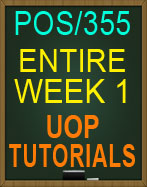 |
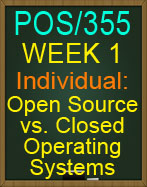 |
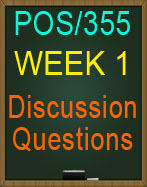 |
POS/355 Week 1Everything Listed for Week 1 is included in Tutorial purchase! Individual: Open Source vs. Closed Operating Systems
|
||
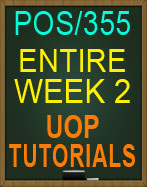 |
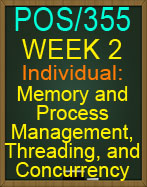 |
 |
POS/355 Week 2Everything Listed for Week 2 is included in Tutorial purchase!
Learning Team: Operating Systems Project, Part I Includes Option #2 Word document with Diagrams Review your Learning Team Assignment Instructions found in Week One and select the type of presentation your team will submit for your final project. Begin building your final project due in Week Five.For this week's assignment, select one Network Operating System, one Standalone Operating System, and one Mobile Device Operating System. Complete the following for each Operating System: • Create an Architectural Operating System diagram showing the communication channels between all three systems. Create a reference log that identifies the resources and/or references you used in creating
your diagram. between all three systems. Create a reference log that identifies the resources and/or references you used in creating your
diagram. between all three systems as they interact. Create a reference log that identifies the resources and/or references you used
in creating your diagram.
Individual: Memory and Process Management, Threading, and
Concurrency
Discussion Questions (included) NOTE: Discussion Questions may be different, depending on which Instructor you get.
Discussion Question: Process Management
Supporting Activity: Concurrency How would you rank the principles of concurrency? Explain the design issues for which the concept of concurrency is relevant.
Supporting Activity: Device Management Consider the past couple days you have worked on the computer. What disk scheduling policies and algorithms were used? Explain.
|
||
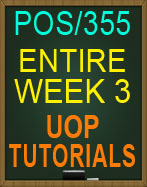 |
 |
 |
POS/355 WEEK 3Everything Listed for Week 3 is included in Tutorial purchase!
Learning Team: Operating Systems Project, Part II (OS) your team selected (one Network OS diagram, one Standalone OS diagram, and one Mobile Device OS diagram). Include a reference log that identifies the resources and/or references
you used in creating your diagram. complete: five key facts in Network OS Management, Standalone OS Management, and Mobile Device OS management Include a reference log that identifies the resources and/or references
you used in creating your diagram. Network OS Management, Standalone OS Management, and Mobile Device OS management Include a reference log that identifies the resources and/or references you used in creating your
diagram.
Individual: File Management Operating Systems: that explains Operating System File Management and Concurrency. Use a minimum of two supporting diagrams to visually represent file management. Include the narrator notes and diagrams as separate attachments. Add a reference log that identifies the resources and/or references you used in your presentation.
Discussion Questions (included) NOTE: Discussion Questions may be different, depending on which Instructor you get.
Discussion Question: Monitoring Processor Performance Research tools that can be used to monitor the processor performance for Windows®, Linux®, and Mac® OSX.
Supporting Activity: OS Server Search the Internet for operating system, focusing on Windows Server and Windows desktop OS. Based on your web search,what are the differences and similarities between Windows Server OS and the desktop OS version?
Supporting Activity: Embedded OS What are some of the key characteristics of an embedded OS? Discuss why they are important. Describe some examples of markets where embedded systems are used.
|
||
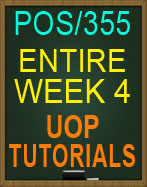 |
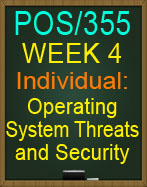 |
|
POS/355 WEEK 4Everything Listed for Week 4 is included in Tutorial purchase! Learning Team: Operating Systems Project, Part III
|
||
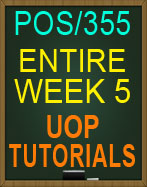 |
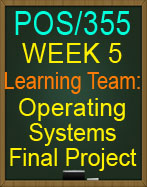 |
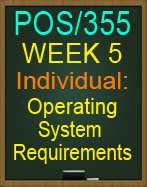 |
POS/355 WEEK 5Everything Listed for Week 5 is included in Tutorial purchase!
Learning Team: Operating Systems Final Project notes, that uses all of the diagrams, charts, or other artifacts created during Weeks Two, Three, Four, and Five, to convince the executive sponsors to purchase your team's recommended Operating System for all three types of Operating Systems; Network OS, Standalone OS, and Mobile Devices OS. Title, agenda, or reference slides are not considered in the minimum slide
count. other artifacts created during Weeks Two, Three, Four, and Five, to convince the executive sponsors to purchase your team's recommended Operating System for all three types of Operating Systems; Network OS, Standalone OS, and Mobile Devices OS. Examples of tools you may use include your mobile phone video recording software or other video recording software you have
available. other artifacts created during Weeks Two, Three, Four, and Five, to convince the executive sponsors to purchase your team's recommended Operating System for all three types of Operating
Systems; Network OS, Standalone OS, and Mobile Devices OS. explain the purpose of each; Network OS, Standalone OS,
and Mobile Devices OS. least three risks for each system or a combination that
impacts all Operating Systems.
Individual: Operating System Requirements Includes Option #2
Discussion Questions (included) NOTE: Discussion Questions may be different, depending on which Instructor you get.
Discussion Question: Mobile Operating Systems Research a mobile operating system processor, memory, and file management.
Supportiing Activity: Computer Security Describe the types of malware and the potential impact they can have on a system. Explain the countermeasures to various types of malware. Supporting Activity: Mobile OSs What are mobile OSs you have personally used? Describe the advantages and disadvantages of their effects. Share a resource you have found regarding mobile OSs.
|
||






